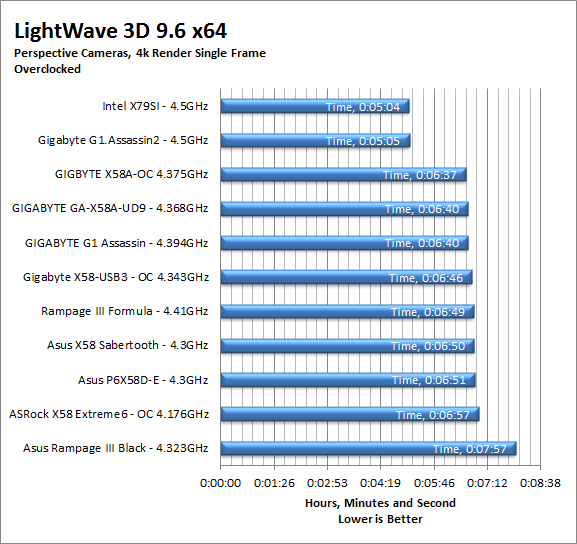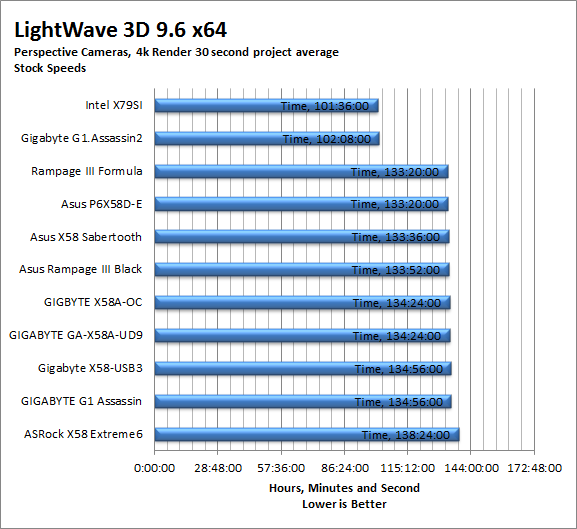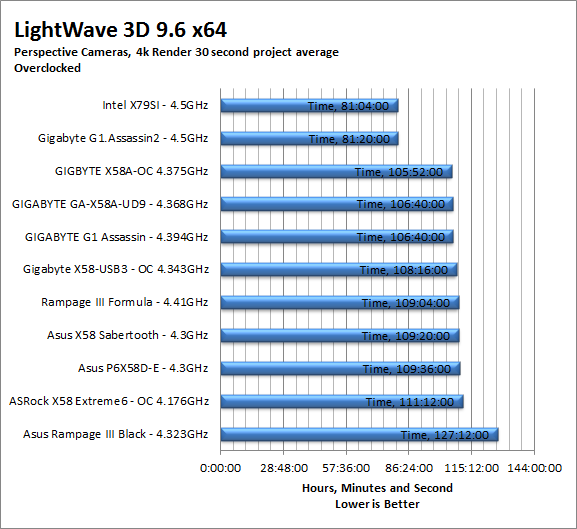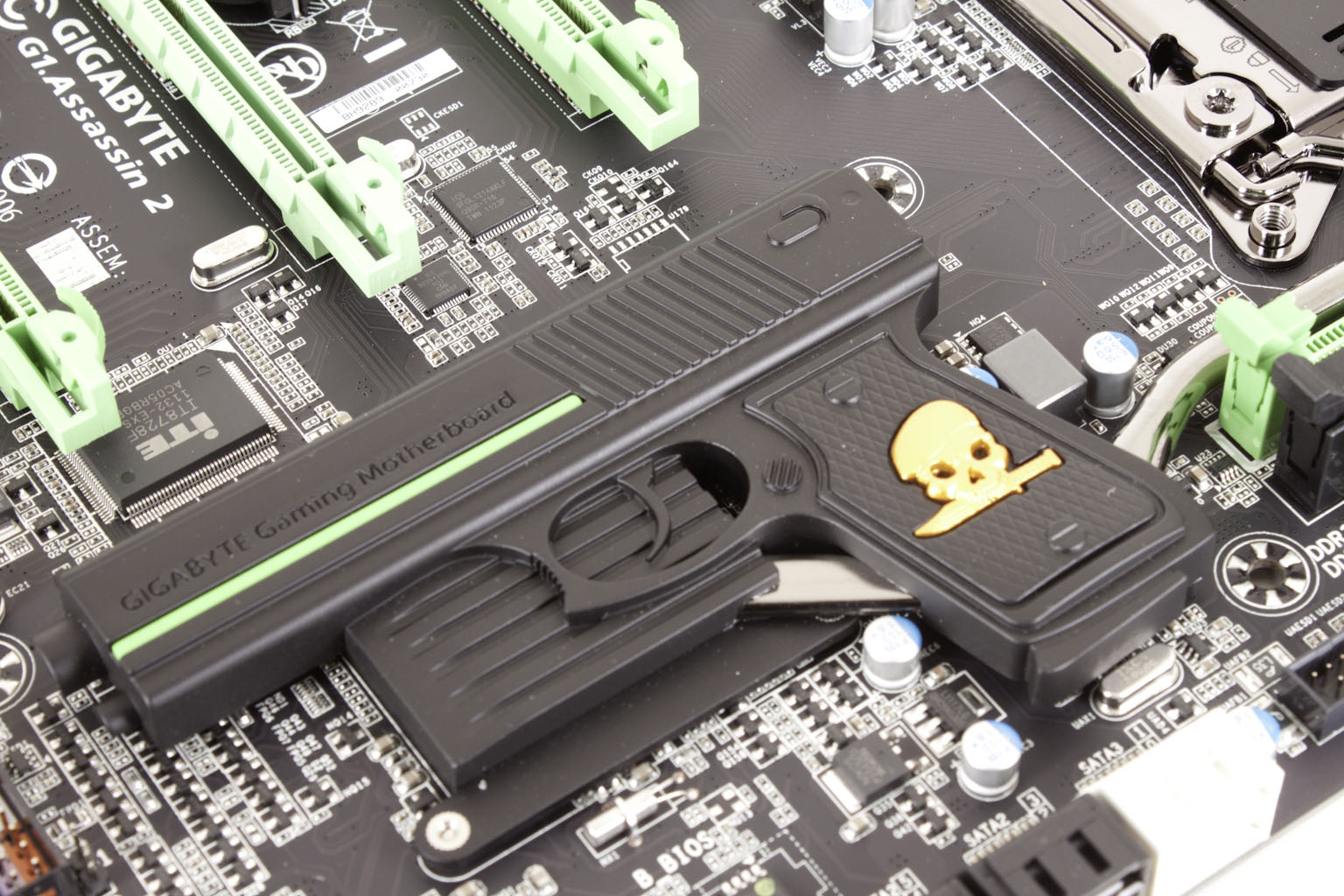Section III - Performance Tests, Real-World
Here we have two tests that are designed to put the performance of the motherboard and its subsystems to the test. Both require good CPU, Memory, HDD and even to a lesser extent audio and network performance. The two tests we chose were Lightwave 3D 9.6 and AutoGK 2.55. We will be adding at least one more real-world test to this battery in the near future, but for now these two cover quite a bit.
Lightwave 3D 9.6 x64 -
Lightwave is another industry standard application for 3D animation and rendering. It has a large tool base and the rendering engine is highly threaded (when using the right render model). This application is also capable of expanding to 4k resolutions as well as ray tracing for rending the light sources. For our testing we use frame 470 of the Pinball scene found in the LW 9 Content folder. This uses the newer perspective camera that is better suited to a multi-CPU/Core environment. This camera style also uses ray tracing and a much improved anti-aliasing method. Settings are shown below in the attached screen shot. Of course these are single frame renders and they are not a complete picture; for that you have to take into account the number of frames an average project would have. In a typical 30 second commercial you will have around 840 to 960 frames (at 28 – 32 FPS) this means that you have to multiply the time of a single frame by that number just to get a vague idea of how long that 30 seconds would take. This is because each frame will have a different render time based on complexity.
We find almost the same story that we saw with Cinebench in our Lightwave testing. The only difference is that the X79SI is slightly faster in each case. The estimated project times show what the 1-2 second difference can do to a full scale project. Looking at what both boards are doing we suspect that this is because of the slower HDD speeds between the two boards. The X79 can simply pull project information from the HDD faster than the G1.Assassin2 can.


AutoGK 2.55 Transcoding -
AutoGK is a transcoding software that is really multiple parts combined to make an easy to use whole. It combines, items like FDD Show, Xvid encoder, Virtual Dub and others for use in converting one media format to another (usually Xvid AVI). It will not transcode copy protected DVDs or Bluray discs yet (you still need a de-crypter for that). But it does an excellent job on everything else. For our testing we use a 2 hour movie that has been placed onto a standard definition DVD for playback; we then transcode this DVD to a 100% quality AVI with the original audio intact. This puts a strain on the CPU, Memory, HDD and the attached DVD ROM drive.
We are still not able to get AutoGK to work and we are certain that this is an issue with the way the new CPU and Chipset work. We have narrowed down our choice for transcoding app to three main selections we are still checking to make sure there are no vendor specific optimizations in these before we make our choice.

 We have now had the G1.Assassin2 up on the test bench for a little over a week now and are ready to talk about our experience with it. The G1.Assassin2 is Gigabyte’s current top of the line x79 motherboard and follows in the same trend as the other boards in the G1 line up. This means that you get the military theme, the built in audio card, and of course the KillerNIC E2100 NPU. However, there are also things that had us concerned about how the G1.Assassin2 might handle certain types of work. So let’s get started and see if all of the new features (like the 3D BIOS and 3D Power) work and if the concerns that we talked about in the
We have now had the G1.Assassin2 up on the test bench for a little over a week now and are ready to talk about our experience with it. The G1.Assassin2 is Gigabyte’s current top of the line x79 motherboard and follows in the same trend as the other boards in the G1 line up. This means that you get the military theme, the built in audio card, and of course the KillerNIC E2100 NPU. However, there are also things that had us concerned about how the G1.Assassin2 might handle certain types of work. So let’s get started and see if all of the new features (like the 3D BIOS and 3D Power) work and if the concerns that we talked about in the 

